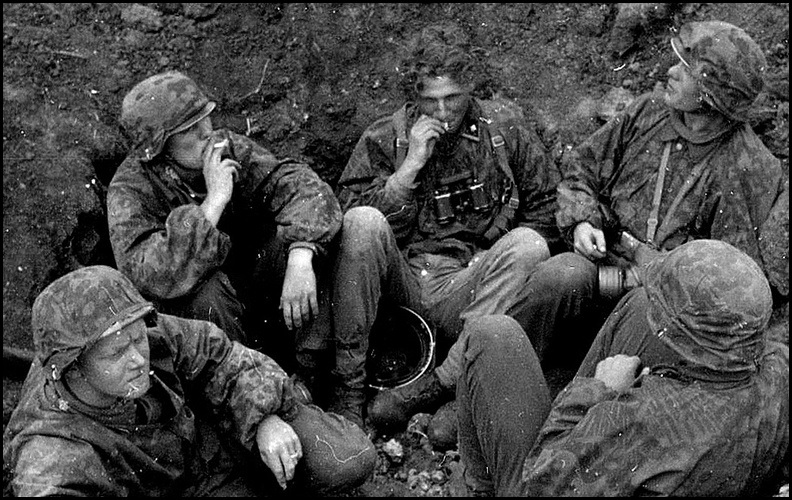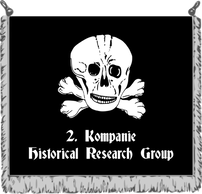waffen-ss camouflage
ss sMOCKS
TYPE I PATTERN SS SMOCK - PLANE TREE 1/2 VT VARIANT
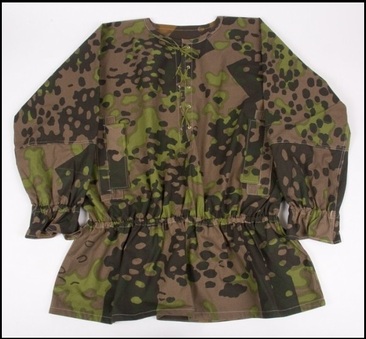
Date: 1936-1942
Production: Produced in factories throughout Germany, large numbers in Concentration Camps.
The Waffen-SS was the first branch of the German military to make use of camouflage smocks and helmet covers. The idea, conceived by Felix Steiner, had smocks in service as early as the invasion of Poland.
This style of smock, known as a Type I was designed to be worn over the field equipment and were made very large, with a low waist band, and vertical slits above the waist band for easy access to the equipment. However, this was not done in practice, and men commonly wore their equipment over the smocks, and in turn, rolled up the bottoms, to have access to their lower tunic pockets.
Production: Produced in factories throughout Germany, large numbers in Concentration Camps.
The Waffen-SS was the first branch of the German military to make use of camouflage smocks and helmet covers. The idea, conceived by Felix Steiner, had smocks in service as early as the invasion of Poland.
This style of smock, known as a Type I was designed to be worn over the field equipment and were made very large, with a low waist band, and vertical slits above the waist band for easy access to the equipment. However, this was not done in practice, and men commonly wore their equipment over the smocks, and in turn, rolled up the bottoms, to have access to their lower tunic pockets.
TYPE II PATTERN SS SMOCK - BLURRED EDGE PATTERN
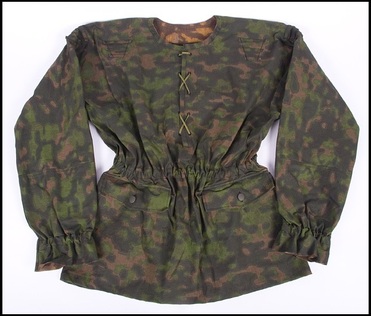
Date: 1942-1944
Production: Produced in factories throughout Germany, large numbers in Concentration Camps.
In 1942, the SS improved their smock design, making them slimmer, raising the waist band, and adding two pockets below the waist band.
This pattern is shown in mid-war blurred edge. As with the Type I, all smocks were made reversible from spring to fall side. Spring side being shown here.
Although this style of smock was discontinued with the advent of the Dot uniform set, they were still issued until the end of the war.
Production: Produced in factories throughout Germany, large numbers in Concentration Camps.
In 1942, the SS improved their smock design, making them slimmer, raising the waist band, and adding two pockets below the waist band.
This pattern is shown in mid-war blurred edge. As with the Type I, all smocks were made reversible from spring to fall side. Spring side being shown here.
Although this style of smock was discontinued with the advent of the Dot uniform set, they were still issued until the end of the war.
SS CAMOUFLAGE COMBINATION SUITS "KOMBI"
field made kombi - plane tree/oak a variants

Date: 1943-1945
Production: Custom tailored in the field.
This version of the Panzer "Kombi", a reversible coverall first issued in 1943 to tank crews as their typical black uniforms failed to provide any camouflage advantage when the men were outside their vehicles.
Additionally, it was soon learned that the presence of soldiers in black uniforms alerted the enemy that an armored unit was in the area.
The reversible step-in coverall bears Fall and Spring camo patterns in Plane Tree No. 2 and Oak Leaf patterns, with six original "glass" buttons securing the front, the lowest button hole at a diagonal, one button missing on the oak leaf pattern side.
Each side bears two deep chest pockets and two waist slash pockets (lined in a green herringbone twill), and all pockets are likewise secured by buttons.
Shoulders bear loops and buttons for shoulder boards. The suit, cut generously so that it could be worn over the traditional black uniform, bears an elastic at the waist and cotton drawstrings at the bottom of each pant leg.
Production: Custom tailored in the field.
This version of the Panzer "Kombi", a reversible coverall first issued in 1943 to tank crews as their typical black uniforms failed to provide any camouflage advantage when the men were outside their vehicles.
Additionally, it was soon learned that the presence of soldiers in black uniforms alerted the enemy that an armored unit was in the area.
The reversible step-in coverall bears Fall and Spring camo patterns in Plane Tree No. 2 and Oak Leaf patterns, with six original "glass" buttons securing the front, the lowest button hole at a diagonal, one button missing on the oak leaf pattern side.
Each side bears two deep chest pockets and two waist slash pockets (lined in a green herringbone twill), and all pockets are likewise secured by buttons.
Shoulders bear loops and buttons for shoulder boards. The suit, cut generously so that it could be worn over the traditional black uniform, bears an elastic at the waist and cotton drawstrings at the bottom of each pant leg.
HBT CAMOUFLAGE UNIFORMS
hbt camouflage uniform - dot 44 pattern
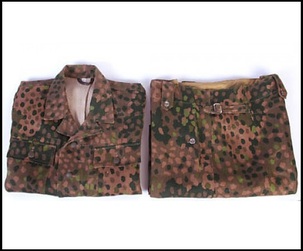
Date: 1944-1945
Production: Produced in factories throughout Germany, large numbers in Concentration Camps.
In 1943, in order to save materials, the SS decided to replace the summer Drillich uniform with a camouflage uniform, which would also replace the smocks, commonly issued to SS troops.
These saw wide use in the last years of the war, especially with formations formed after 1943. These were not seen in use by SS-Totenkopf until the summer of 1944.
Production: Produced in factories throughout Germany, large numbers in Concentration Camps.
In 1943, in order to save materials, the SS decided to replace the summer Drillich uniform with a camouflage uniform, which would also replace the smocks, commonly issued to SS troops.
These saw wide use in the last years of the war, especially with formations formed after 1943. These were not seen in use by SS-Totenkopf until the summer of 1944.
ss camouflage field caps
SS FIELD CAP - BLURRED EDGE PATTERN
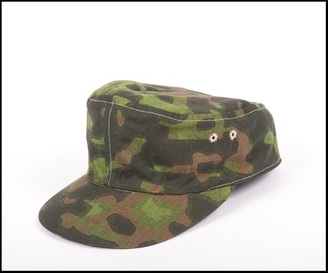
Date: 1942-1945
Production: Custom tailored in the field.
Camouflage caps were produced by unit tailors, and seen in large numbers by SS troops throughout the war. SS-Divisions "Nord" and "Totenkopf" are seen wearing this style of cap in many photos.
They were made in every style of camouflage pattern, as well in different patterns. Simple ones, like pictured, and also styles modeled after the M43 field cap.
Production: Custom tailored in the field.
Camouflage caps were produced by unit tailors, and seen in large numbers by SS troops throughout the war. SS-Divisions "Nord" and "Totenkopf" are seen wearing this style of cap in many photos.
They were made in every style of camouflage pattern, as well in different patterns. Simple ones, like pictured, and also styles modeled after the M43 field cap.
SS HELMET COVERS
TYPE I SS HELMET COVER - PLANE TREE 1/2 VARIANT
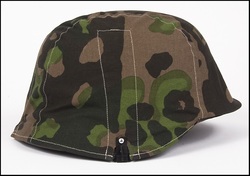
Date: 1936-1943
Production: Produced in factories throughout Germany, large numbers in Concentration Camps.
Camouflage helmet covers began their use with the first time during trials in 1936. The first style created, known as a Type I, is pictured to the left. It features three rocker clips to attach it to the helmet, and is reversible with spring and fall sides. spring shown.
Production: Produced in factories throughout Germany, large numbers in Concentration Camps.
Camouflage helmet covers began their use with the first time during trials in 1936. The first style created, known as a Type I, is pictured to the left. It features three rocker clips to attach it to the helmet, and is reversible with spring and fall sides. spring shown.
TYPE II SS HELMET COVER - BLURRED EDGE PATTERN
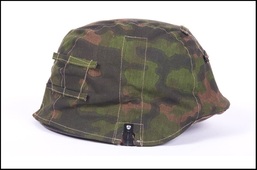
Date: 1943-1945
Production: Produced in factories throughout Germany, large numbers in Concentration Camps.
Type II helmet covers began to replace the earlier Type I style in great numbers in 1943. This style of helmet cover still featured three rocker clips, and differed from the earlier style with foliage loops attached to the front and the back to assist in adding additional camouflage.
Production: Produced in factories throughout Germany, large numbers in Concentration Camps.
Type II helmet covers began to replace the earlier Type I style in great numbers in 1943. This style of helmet cover still featured three rocker clips, and differed from the earlier style with foliage loops attached to the front and the back to assist in adding additional camouflage.
SS ZELTBAHN
SS ZELTBAHN - BLURRED EDGE PATTERN
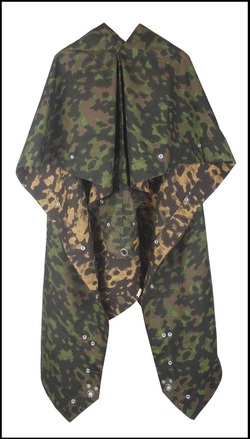
Date: 1936-1945
Production: Produced in factories throughout Germany, large numbers in Concentration Camps.
The German Army used Zeltbahns since the First World War. By WWII, the German zeltbahn was cut in a triangular pattern, and four were buttoned together to form a single tent.
Zeltbahns were made in the following patterns:
SS-VT Plane Tree 1-6
Plane Tree Overprint 1-6
Oak A
Oak B
Blurred Edge
Each soldier was issued a zeltbahn, which was worn rolled up in an A-frame, or attached to the belt. When not worn, the zeltbahn doubled as a tent, and also had a hole for the head, so the zeltbahn could be used as a water-proof poncho.
Production: Produced in factories throughout Germany, large numbers in Concentration Camps.
The German Army used Zeltbahns since the First World War. By WWII, the German zeltbahn was cut in a triangular pattern, and four were buttoned together to form a single tent.
Zeltbahns were made in the following patterns:
SS-VT Plane Tree 1-6
Plane Tree Overprint 1-6
Oak A
Oak B
Blurred Edge
Each soldier was issued a zeltbahn, which was worn rolled up in an A-frame, or attached to the belt. When not worn, the zeltbahn doubled as a tent, and also had a hole for the head, so the zeltbahn could be used as a water-proof poncho.
ss-Camouflage patterns
No patterns produced at the beginning of the war were production at its end. Everything was experimental.
SS-VT Plane tree #1-6 pre-war patterns
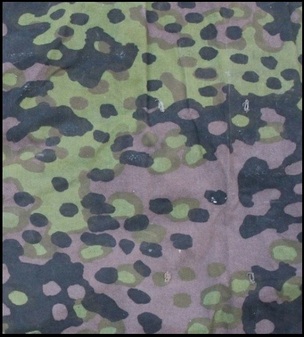
Date: 1936-1940
Production: Alle, außer Fallschirmjäger Kleidung. (All types except paratroop clothing.)
This multi-purpose design was manual screen printed using three dyes also. The Plane Tree pattern was the longest surviving design, in use until 1944. These models tended to have large patterned areas and fewer spots, with open expanses of no darker prints. There were six designs produced to be used in a standard six man tent.
The numbers were merely used in construction to match corresponding segments. Even though there were six differing designs, the designs still allowed for effective flow between random connection of zelts. Basically, if you had a #1 zelt and connected it with a #5, the pattern created after mating the two would still be effective, and likewise for any combination.
Production: Alle, außer Fallschirmjäger Kleidung. (All types except paratroop clothing.)
This multi-purpose design was manual screen printed using three dyes also. The Plane Tree pattern was the longest surviving design, in use until 1944. These models tended to have large patterned areas and fewer spots, with open expanses of no darker prints. There were six designs produced to be used in a standard six man tent.
The numbers were merely used in construction to match corresponding segments. Even though there were six differing designs, the designs still allowed for effective flow between random connection of zelts. Basically, if you had a #1 zelt and connected it with a #5, the pattern created after mating the two would still be effective, and likewise for any combination.
SS-VT LATERAL VARIANT pattern
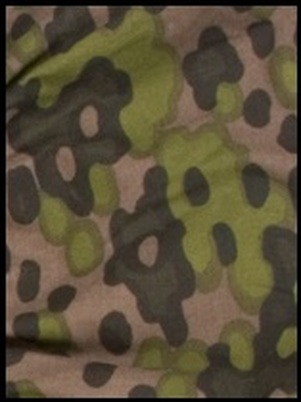
Date: 1938-1940
Production: Stahlhelmbezüge, Tarnjacken.
This pattern was the first model to incorporate the later spotted type appearance of Plane Tree patterns. This scarce pattern replaced the early block pattern, and was more or less a more compact version of the block pattern.
Three dyes were used in manual screening to give the appearance of four colors once again. This was intended for use in clothing only so, it carried no associated numbers like other Plane Tree patterns.
The name was derived from the lateral effect of the print when viewed horizontally.
Production: Stahlhelmbezüge, Tarnjacken.
This pattern was the first model to incorporate the later spotted type appearance of Plane Tree patterns. This scarce pattern replaced the early block pattern, and was more or less a more compact version of the block pattern.
Three dyes were used in manual screening to give the appearance of four colors once again. This was intended for use in clothing only so, it carried no associated numbers like other Plane Tree patterns.
The name was derived from the lateral effect of the print when viewed horizontally.
palm pattern
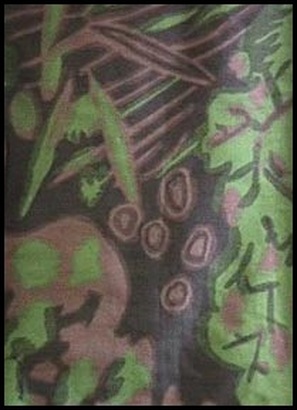
Date: 1940-1942
Production: Stahlhelmbezüge, Tarnjacken.
This was the first pattern to be printed by rollers, and was distributed in mass for the invasion of Russia.
It was made using five different colors and designed for clothing use only.
Zeltbahns were never made in this pattern, and it was issued in larger numbers to SS-Totenkopf.
Production: Stahlhelmbezüge, Tarnjacken.
This was the first pattern to be printed by rollers, and was distributed in mass for the invasion of Russia.
It was made using five different colors and designed for clothing use only.
Zeltbahns were never made in this pattern, and it was issued in larger numbers to SS-Totenkopf.
SS-VT PLANE TREE POLY SPOT pattern
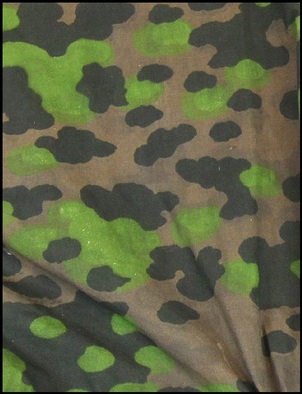
Date: 1941
Production: Stahlhelmbezüge, Tarnjacken.
Pattern similar to the Lateral Variant, but it lacked a lateral sweep in the forms.
Like the early prints this also used three dyes, and was likely the last fully hand screened pieces of Plane Tree artwork.
Production: Stahlhelmbezüge, Tarnjacken.
Pattern similar to the Lateral Variant, but it lacked a lateral sweep in the forms.
Like the early prints this also used three dyes, and was likely the last fully hand screened pieces of Plane Tree artwork.
Plane tree #1-6 - wartime patterns
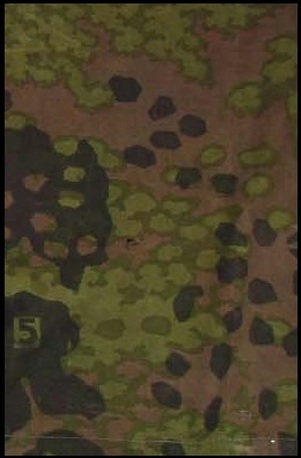
Date: 1940-1944
Production: Alle, außer Fallschirmjäger Kleidung. (All types except paratroop clothing.)
There were several different variations of these patterns. As screens were reproduced to increase production by new manufacturers, disparities appeared. These versions tended to have a smaller, more spotted appearance.
The earlier Plane Tree printers were manually screened, but in 1941 machine printing of background patterns commenced. This underlay was very different from the original underlay.
It used the newly introduced Oak Leaf pattern. Printed in two tones, it gave the appearance of three.
The darker parts of the Plane Tree design was still applied by hand.
Production: Alle, außer Fallschirmjäger Kleidung. (All types except paratroop clothing.)
There were several different variations of these patterns. As screens were reproduced to increase production by new manufacturers, disparities appeared. These versions tended to have a smaller, more spotted appearance.
The earlier Plane Tree printers were manually screened, but in 1941 machine printing of background patterns commenced. This underlay was very different from the original underlay.
It used the newly introduced Oak Leaf pattern. Printed in two tones, it gave the appearance of three.
The darker parts of the Plane Tree design was still applied by hand.
blurred edge pattern
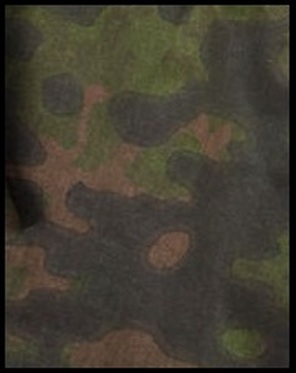
Date: 1941-1944
Production: (All types except paratroop clothing.)
This pattern was a unique design of shadows and foliage.
It was comprised of a three tone Oak Leaf underlay with an overprinted two tone shadow.
Production: (All types except paratroop clothing.)
This pattern was a unique design of shadows and foliage.
It was comprised of a three tone Oak Leaf underlay with an overprinted two tone shadow.
oak a and oak b pattern
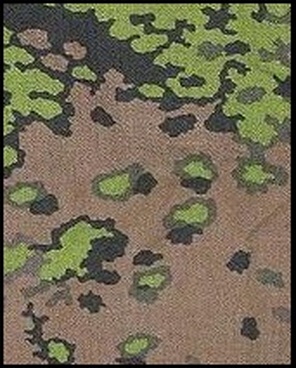
Date: 1941-1945
Production: Alle, außer Fallschirmjäger Kleidung. (All types except paratroop clothing.)
By adding two additional colors to the Oak Leaf base used in both Blurred Edge and later Plane Tree patterns, a whole new pattern was born.
However, since much of this base material was used in already pre-existing patterns, the early “A” pattern was quite scarce compared to its later counterpart.
The “B” pattern was a crude reproduction of the “A” pattern, it had softer edges and outlined designs.
Oak Leaf was not discontinued with the introduction if the Dot pattern and continued being produced through 1945.
Production: Alle, außer Fallschirmjäger Kleidung. (All types except paratroop clothing.)
By adding two additional colors to the Oak Leaf base used in both Blurred Edge and later Plane Tree patterns, a whole new pattern was born.
However, since much of this base material was used in already pre-existing patterns, the early “A” pattern was quite scarce compared to its later counterpart.
The “B” pattern was a crude reproduction of the “A” pattern, it had softer edges and outlined designs.
Oak Leaf was not discontinued with the introduction if the Dot pattern and continued being produced through 1945.
dot 44
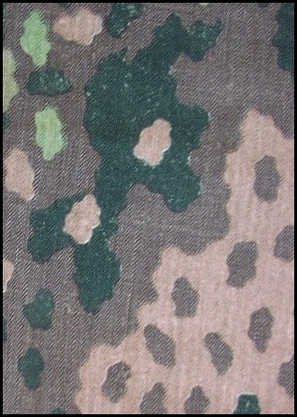
Date: 1944-1945
Production: Zweiteilige Uniformen (Two-piece Uniforms), Winterbekleidung (Winter Clothes), Fallschirmjäger Tarnjacken (Paratrooper Smocks).
Designed to replace all other types of SS camouflage, this pattern was introduced early in 1944 with a two piece camouflage uniform.
Five different colors were used, and this is the last pattern produced by the SS to see distribution.
Production: Zweiteilige Uniformen (Two-piece Uniforms), Winterbekleidung (Winter Clothes), Fallschirmjäger Tarnjacken (Paratrooper Smocks).
Designed to replace all other types of SS camouflage, this pattern was introduced early in 1944 with a two piece camouflage uniform.
Five different colors were used, and this is the last pattern produced by the SS to see distribution.
For an in-depth view and analysis of the most common pattern of SS Camouflage, Plane Tree, please check out the article written by 2. Kompanie member, SS-Stze. Ottoklar Zwilingi, located HERE.
Some images used courtesy of S.M. Wholesale U.S.A.
Other Source:
Beavers, Michael D., and J.F. Borsarello.
Camouflage Uniforms of the Waffen-SS.
Atglen, PA: Schiffer Military/ Aviation History, 1995. Print.
Other Source:
Beavers, Michael D., and J.F. Borsarello.
Camouflage Uniforms of the Waffen-SS.
Atglen, PA: Schiffer Military/ Aviation History, 1995. Print.
